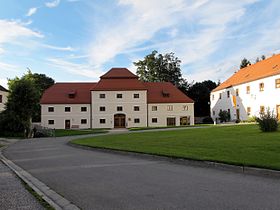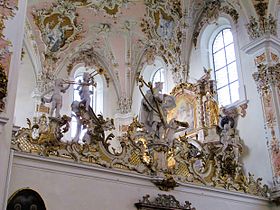 | ||
| Rottenbuch | ||
| federal state | Bavaria | |
|---|---|---|
| Residents | 1.825 (2019) | |
| height | 763 m | |
| no tourist info on Wikidata: | ||
| location | ||
| ||
The community Rottenbuch is a state-approved resort in Pfaffenwinkel / Upper Bavaria. The Rottenbuch monastery (Augustinian Canons) is one of the most influential monasteries in the region in its heyday.

background

Rottenbuch lies on the edge of the Ammer Gorge. The name is traced back to a beech clearing during the founding of the monastery, another derivation is that of "raiten" for judge than the location of a legal or council book.
The place Rottenbuch has its history as a settlement of the servants and craftsmen at the monastery.
The political community Rottenbuch has 26 districts.
The Foal market Rottenbuch is first mentioned in a document in 1558. With up to 7000 visitors, it is the largest and oldest in Germany and takes place every year in September.
getting there
| Distances (road km) | |
| Schongau | 17 km |
|---|---|
| Oberammergau | 20 km |
| Weilheim | 22 km |
| Garmisch | 39 km |
| augsburg | 83 km |
| Munich | 88 km |
Rottenbuch is on the B23 federal road (romantic street) in the section Schongau - Oberammergau.
By plane
The next major airport is "Franz Josef Strauss" Near Munich (approx. 135 km away), the Innsbruck Airport is approx. 94 km away.
By train
The nearest train stations are the in Weilheim (22 kilometers) and the in Bad Kohlgrub (11 km away) at the Ammergaubahn, also Ammertalbahn. The Ammertalbahn connects Oberammergau in Murnau with the Munich - Garmisch-Partenkirchen line info;
Continue from the train stations with the bus or taxi.
Timetable information from train;
In the street
- Of north / east: Via the A95 motorway, Munich-Garmisch-Partenkirchen,
 Sindesldorf, continue on the state road to Rottenbuch;
Sindesldorf, continue on the state road to Rottenbuch;
- Of west: on the A96
 Landsberg and on the B17 to Schongau and then on the B23 to Bad Bayersoien.
Landsberg and on the B17 to Schongau and then on the B23 to Bad Bayersoien.
- Of south: Over Garmisch-Partenkirchen and the federal road B2 to Oberau, then on the federal road 23 over Oberammergau and Bad Bayersoien to Rottenbuch;
mobility
The RVO (Regionalverkehr Oberbayern / DB) operates the bus routes in the region;
- Regionalverkehr Oberbayern GmbH, Hirtenstrasse 24, D-80335 Munich; Tel .: 49 / (0) 89 / 55164-0 info;
The bus routes through Rottenbuch are:
- Line 9651: Weilheim-Peißenberg-Steingaden-Füssen;
- Line 9822: Schongau-Rottenbuch-Echelsbacher Brücke-Saulgrub / Steingaden
Tourist Attractions

Rottenbuch monastery
A first cell made up of hermits is believed to date back to the 10th century; the monastery was consecrated as a monastery by the Augustinian Canons around 1073 by Duke Welf I of Bavaria. Rottenbuch was a papal monastery and im Investiture Controversy (1076 - 1122) the Popes with Henry IV. A place of refuge for those who were loyal to the Pope in the Empire.
In addition, the monastery achieved its first heyday in the 12th century and was of great importance as a mother monastery and for the reforming of the monastery communities at that time, including the Rottenbuch reform circle Prince Provost Berchtesgaden and the Dießen Monastery, the construction of the Romanesque basilica is classified in the period around 1085 - 1125.
Political circumstances, fires in 1262 and 1322, an attack by the Tyroleans in 1413 and the collapse of the church tower in 1417 indicate the decline of the monastery; it recovered in the 15th century, but then experienced the general decline in the peasant wars in the 16th century and in the Thirty Years War (1618-1648).
In the baroque period the ascent took place again, the monastery church was redesigned in baroque style, from 1750 the monastery complex was greatly expanded.
With the exception of the church, the monastery complex was built in a comparatively unadorned form; The reason for this was that the monastery convent consisted of up to 40 canons and employed over 100 people in the factories, but these mostly older and pensionable workers were mainly employed from a social point of view as pension recipients.
During the secularization in 1803, the monastery was closed and the workers fired. A manufacturer bought most of the buildings for demolition, only the church and a few outbuildings could be saved. The monastery library was housed in the paper mill. In 1963, the Don Bosco sisters took over the buildings that had been preserved.
Collegiate church


The collegiate church "Virgin Mary's Birth" was built as a Romanesque three-aisled basilica with transept and western vestibule in the 11th century; it was expanded in the late Gothic period and provided with a stone cross-ribbed vault. From this period (1483) there is still the figure of Our Lady (preserved in the left side altar, a work of the master) Erasmus Grasser.
The 67 m high and free-standing tower as a campanile dates from 1439 and is the landmark for the monastery and the place.
From 1737 to 1750 the church was dated Wessobrunn plasterer and builder Joseph Schmuzer and son Franz Xaver in Baroque style. The 25 main frescoes and the secondary frescoes are from Mathias Günther, they show the life story of St. Augustine and are considered a high point of the Rococo.
Altars and pulpit are from Franz Xaver Schmädl, the angels in Rottenbuch are particularly vital and happy. The organ prospectus also comes from Franz Xaver Schmädl, the prospectus is counted among the most beautiful and closed rococo ensembles in Bavaria.
For more information about the monastery and church, see the website of Rottenbuch.
activities
Rottenbuch is located on several long-distance hiking trails:
- "Munich Way of St. James"
- "Prelate Path"
- "King Ludwig Way"
shop

kitchen
- Hubertus Tubes (Bavarian cuisine, beer garden), Franz-von-Herren-Str. 7, 82401 Rottenbuch (in the monastery grounds). Tel.: 49 (0)8867 919981.
- To the cook (Country inn), Am Klosterhof 26, 82401 Rottenbuch. Tel.: 49 (0)8867 921195.
nightlife
accommodation
health
| Brief information | |
| surface | 31.45 km² |
|---|---|
| Phone code | 08867 |
| Post Code | 82401 |
| Mark | WM |
| Time zone | UTC 1 |
| Emergency call | 112 / 110 |
- General practitioners and dentists are represented in town
- Welfen pharmacy, Welfenstrasse 1, 82401 Rottenbuch. Tel.: (0)8867 92027.
- The closest primary care hospital is this Schongau Hospital
Practical advice
- Tourist-Info Rottenbuch, Klosterhof 42, 82401 Rottenbuch. Tel.: 49 (0)8867 9110-18. Open: Mon, Wed, Fri, from 10 a.m. to 12 p.m.
- Deutsche Post (DHL): R. Beck, Klosterhof 30;
trips

- More significant Monastery complexes are in the Pfaffenwinkel SteingadenWessobrunnwho have favourited Monasteries in Andechs, Schlehdorf and Benediktbeuern is not far;
- The Wieskirche, Rococo - pilgrimage church "to the Scourged Savior" is part of the UNESCO world cultural heritage;
- The High Peissenberg is known for its 360 ° panorama.
- That closes in the north Five Lakes Land with the starnberger Lake and the Ammersee at;
literature
- Rottenbuch. Augustinian Canons' Monastery in Ammergau. Contributions to history, art and culture. 1953, ISBN 978-3874371667 ; 204 pages.
Web links
- local community Rottenbuch;
- House of Bavarian History (www.hdbg.de) : Monasteries in Bavaria, Rottenbuch monastery;
- District Office Weilheim-Schongau: www.weilheim-schongau.de;

